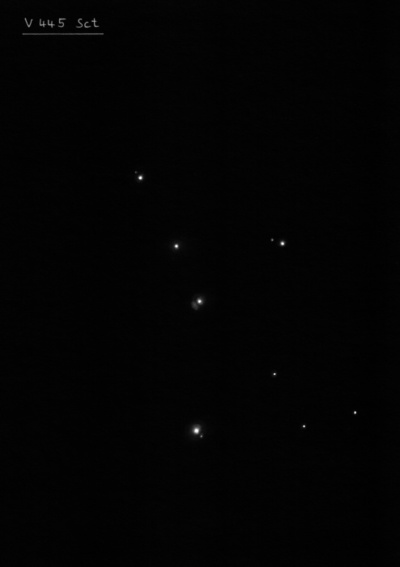A small constellation just south of the celestial equator, below the border of Aquila and the tail of the Serpent, whose brightest stars only reach 4mag, but it's not hard to find - at least under a slightly dark sky. Indeed, the shield lies in a rich part of the Milky Way, on the northwestern boundary, plus it is interspersed with the dark clouds of the Great Rift and projects a very bright star cloud - a large number of distant stars that the eye cannot distinguish and perceives as just a luminous cloud. Seen from Central Europe, it is the brightest brightening ever seen in the available part of the Milky Way.
The cloud in the Shield shows great contrast to its surroundings. It is in this region that you will notice the striking combination of bright star fields with the extremely dark dust clouds of the Great Rift located in the foreground, creating remarkable bays directly in and around the cloud. Particularly striking is the one-degree Barnard 103 nebula, lying between the α and β Scuti stars. In addition, many dark regions of dust are distributed throughout the constellation and have found their numbers in the Barnard Catalogue of Dark Nebulae. Probably the most striking complex (B103, B104, B110, B111 and B113) extends from the Great Rift into the northern parts of the constellation, and its contrast with the surrounding star field is really striking in the binocular. Look for another large dark nebula over one and a half degrees long during good conditions just southeast of γ Sct, in a field crowded with faint stars (B312).
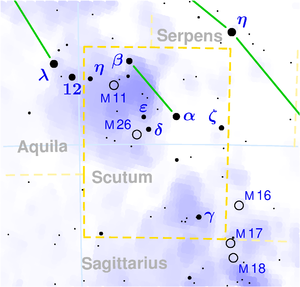
If you look more closely, you'll definitely see that the Cloud in the Shield is irregularly shaped and not just an oval. In the sky from the north it follows the stars λ and 12 AQL, η and β Sct, then heads towards the stars ε and δ Sct, from which it rises back to λ Aql. The open cluster M11 (5.8mag) is visible directly in the cloud with the naked eye. The cloud itself looks like a lively mixture of nebulae under a dark sky, with a few just distinguishable stellar sparks glittering in it. This is a large number of distant stars that the eye cannot distinguish individually and therefore perceives only as a luminous cloud. In fact, it is a kind of window between opaque clouds of interstellar matter through which we can see a relatively large distance towards the centre of the Galaxy. For in this direction we are looking not perpendicularly, but directly along one spiral arm - the Sagittarius arm. This is the innermost of the main arms, and is wide and extensive, encircling almost the whole Galaxy before it begins to disappear.
δ Sct - This star is a prototype of a class of variable stars, whose brightness changes very little due to repeated shrinking and expanding of its diameter with a period of several hours. During 4.65 hours, its brightness fluctuates between 4.9mag and 5.2mag. δ Scuti also has a blue companion at a separation of 52.6", which nicely contrasts with the main, bright yellow star.
R Scuti - A dark yellow supergiant, a semi-regular variable star of RV Tauri type, one degree south of β Scuti (4.2 mm). Its brightness varies from 4.9 mag to 8.2 mag in a period of five months - the main period being 140 days. The deep minimum may be caused by carbon particles forming in the star's atmosphere. It is within the reach of a telescope, as it is the brightest RV Tauri variable star: it seems to oscillate at least in two overlapping periods and at its maximum it is at least 8,000 times more luminous than the Sun. It often changes brightness between 5-6 mag, but after four or five such cycles it drops to 8th magnitude. It is about 2,500 light years away. Similar stars have been found not only in parts of the Milky Way, but also in globular clusters, even in the center of the Galaxy itself.
Struve 2306 - The asterism is observed 1.75 degrees WSW from the star γ Scuti. The AB pair consists of a golden component (7.9 mag) and a blue component (8.6 mag), which are separated by 10.2". The companion is also a close pair that requires a relatively high magnification for resolution.
Struve 2373 - Double star located in a rich field of stars in the Milky Way. It consists of two yellow components with magnitudes of 7.2 and 8.2, which are separated by a distance of 4.2". A reasonable minimum for resolution will be a telescope with a 10 cm objective diameter.
M 11
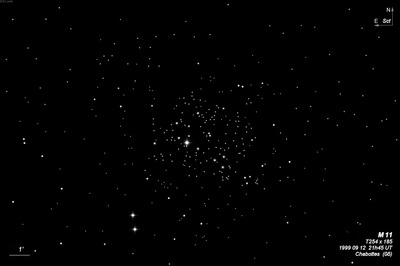
Gottfried Kirch discovered M11 = NGC 6705 = h2019 on 1 Sep 1681 in Leipzig, Germany and made a rough sketch (the bright mag 8 star is prominently drawn but no other stars). William Derham first resolved it around 1733 with an 8-foot (focal length) reflector and described "..not a nebulose, but a cluster of stars, somewhat like that which is in the Milky Way" (PT XXXVIII, 70). De Chéseaux also resolved it into "a wonderful cluster of small stars."
WH observe the cluster with his 10-ft telescope (4-inch aperture) around 1780 and noted the cluster was visible naked-eye. JH wrote (23 Jul 1827), "A beautiful irregularly R cl 10' or 12' diam. The stars are all 11m except one = 9m whose place is taken. Examined with high magnifiers [I have often viewed it with 800 and even 1200]; it is broken into 5 or 6 distinct groups with rifts or cracks between them." Observing with a 9.5" refractor around 1856, Father Secchi described the cluster as having three leaf-shaped dark lanes (AN 43, 157).
The nickname "Wild Duck Cluster" is from Admiral Smyth's 1844 guidebook "A Cycle of Celestial Objects". He describes the telescopic appearance as "A splendid cluster of stars ...which somewhat resembles a flight of wild ducks in shape, is a gathering of minute stars, with a prominent 8th-magnitude in the middle, and two following".
200/250mm - 8" (7/16/82): this is the most impressive open cluster with this aperture. Appears as an extremely rich carpet of faint stars and dense clumps in an arrowhead shape.
300/350mm - 13.1" (7/16/82): at 140x, several hundred stars mag 11-15 and a brighter mag 8 star (SAO 142695) in a 10' region form a remarkably rich cluster including some dense knots of stars. A starless vacuity is visible just west of center at medium power. Dark lanes appear to wind through the cluster at high power grouping the stars into chains. Several dark nebula are near including B108, B112, B318.
Notes by Steve Gottlieb
M 26
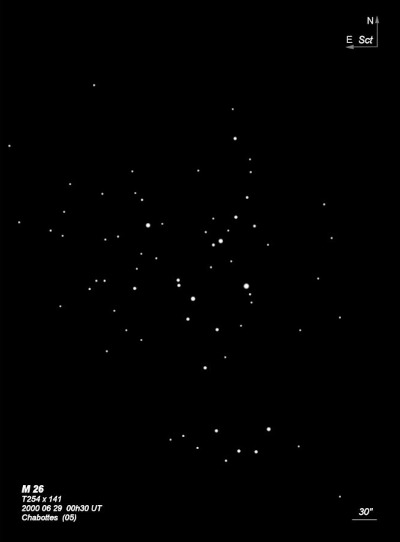
Charles Messier discovered M26 = NGC 6694 = h3758 on 20 Jun 1764. On 16 Jun 1784 (sweep 228), WH noted "a cluster of scattered stars, not rich." JH recorded (sweep 591) "cl VII class; p rich; irreg R; p well insulated; not much comp M; 10' diam; st 12...15m; one 9m taken."
200/250mm - 8" (7/27/84): 20 stars mag 11-13, fairly small. Consists mostly of faint stars except for the four brighter central stars that form a "kite" asterism. Some dense sections of faint stars lie north and south in strings.
300/350mm - 13" (7/27/84): about 40 stars mag 9-14 are resolved in a 7' diameter at 220x. The brightest star is mag 8.8 SAO 142584 at the SW end. A faint group of mag 13.5-14 stars is just east of the main section. Located in a rich field.
400/500mm - 17.5" (6/30/00): this rich, distinctive cluster stands out well in the field at 100x. At 220x, ~60 stars are resolved in a 7' diameter. A mag 9 star marks the SW end. About a dozen stars are arranged in a striking arc (concave to the west) just north of the mag 9 star. A dark lane oriented N-S bisects the cluster just following this star chain and extending past the bright star. On the east side of this lane is a rich group of stars, roughly arranged into two irregular ovals.
Notes by Steve Gottlieb
IC 1295
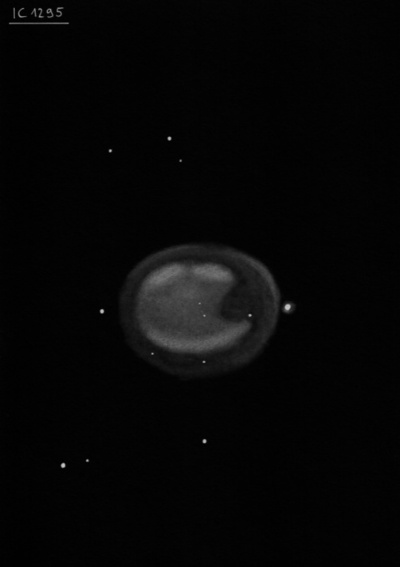
Truman Safford discovered IC 1295 = Sf 82 on 28 Aug 1867 with the 18.5-inch Clark refractor at Dearborn Observatory in Chicago and recorded "pB, pL, gbM." Heber Curtis first recognized it as a planetary nebula in 1919. Burnham's Celestial Handbook and the Sky Atlas 2000.0 mislabel this planetary as IC 1298.
In 1919, Heber Curtis reported it was undoubtedly a planetary nebula based on a Crossley photograph and described it as "Exceedingly faint; a faint, hazy ring about 2' x 1.5' in p. a. 90°±. The central portions are relatively vacant, and it is fainter along and at the ends of the major axis. There are three faint stars at the center, of which one is probably the central star."
100/150mm - 5" visible with a 5" stop on my 13.1" without filter and easy with UHC at 79x!
200/250mm - 8" (6/27/81): faint, round, fairly small. Located 25' ESE of NGC 6712 in the same low power field. Observation mentioned in 10/81 S&T for smallest scope!
300/350mm - 13.1" (7/27/84): the rim on the south or SW side appears brighter but no definite annularity was seen.
13.1" (8/15/82): fairly faint, appears slightly elongated in an E-W orientation.
400/500mm - 17.5" (6/30/00): fairly bright at 220x using a UHC filter as a roundish disc, ~1.6'x1.4'. The surface brightness is irregular and it appears slightly brighter along the southwest and northwest portion of the rim. The unfiltered view at 280x also reveals a mottled appearance with a mag 13.5-14 star situated right at the west edge and a mag 14.5 star in the interior (a bit offset from center). A couple of extremely faint stars are at the following edge. Located 24' ESE of NGC 6712.
17.5" (5/10/86): bright, large, round, 1.5' diameter. Very pretty at 220x, estimate V = 12.0-12.5. The stellar planetary K 4-8 is just 4.6' WNW.
600/800mm - 33" (9/16/07): at 200x appeared weakly annular with a slightly darker hole in the center and slightly brighter rim except on the west edge where there was an indentation or darker notch taking a small bite out of the rim.
Notes by Steve Gottlieb
NGC 6664
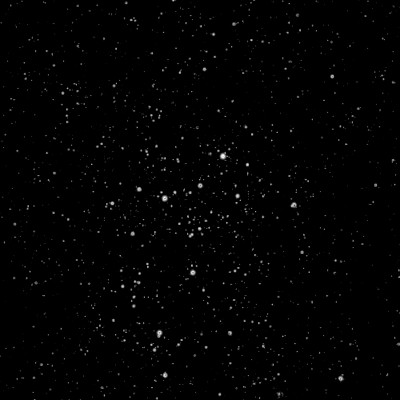
William Herschel discovered NGC 6664 = H VIII-12 = h3754 on 16 Jun 1784 (sweep 228) and recorded "a cluster of very coarsely scattered stars; or, the milky way uncommonly crowded. The cl. did more than fill my field of view." His position is on the east side of the cluster. JH made the single observation "a cl of L stars. It is the commencement of the bright milky way, which here comes on suddenly in the main body."
400/500mm - 17.5" (7/1/89): at 220x, about 100 stars in a 15' scattered field including several mag 11 stars. Many stars are arranged in strings although no dense parts. Located 29' E of Alpha Scuti (V = 3.9).
Notes by Steve Gottlieb
NGC 6712
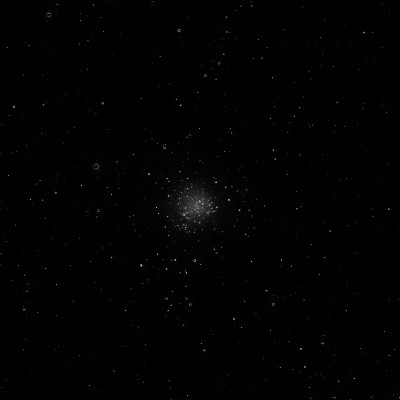
William Herschel discovered NGC 6712 = H I-47 = h3762 on 16 Jun 1784 (sweep 228) and recorded "B, vL, easily resolvable, with many stars visible in it; of an irregular form." John Herschel made a single observation on 27 May 1831 (sweep 591): "globular cluster; pL; F; R; rather irreg; vglbM; 6' or more in diam; all resolved. A fine object, the stars being very close and numerous."
200/250mm - 8" (7/24/82): grainy, very lively but only a few stars resolved over haze at high power. Strong impression that in excellent seeing or a bit more aperture would resolve more fully.
300/350mm - 13.1" (7/27/84): about 15 stars resolved including several extremely faint stars, very mottled, ragged edges, non-symmetric (flattened on the southeast side).
400/500mm - 17.5" (6/29/00): at 220x this is a bright, moderately large cluster, ~6' diameter in a very rich Milky Way field. Contains a relatively large, intense 3' core with a number of very faint stars peppered over the background glow. A small, partially resolved piece is detached at the southeast end by a dark lane. The surrounding halo includes a number of brighter stars, though it is difficult to untangle the maze of stars in the halo from the rich Milky Way background. Roughly 30 stars are resolved at 280x, although it is difficult to accurately count. The core has irregular appearance with a flattened side caused by a sharp light cut off on the south side. PN IC 1295 lies 24' ESE.
17.5" (7/1/89): about two dozen stars resolved over haze. A very rich clump is visible at the west side and a detached clump is at the southeast end. The outline is irregular.
600/800mm - 24" (8/12/15): at 450x (10mm ZAO + 2x Powermate); nearly fills 5' field, excellent resolution over the entire surface with well over 50 stars resolved. A dense group of easily resolved stars is on the west side of the halo. A large number of fainter resolved stars is also on the south side. The outer halo was ragged and straggling, with no distinct border but shot with numerous stars. A well resolved, detached elongated section (separated by a lane) is on the south and southeast side of the halo. Set in a beautiful low power field with planetary nebula IC 1295 24' ESE. Observation at 8600 ft in excellent transparency in the White Mountains.
Notes by Steve Gottlieb
NGC 6649
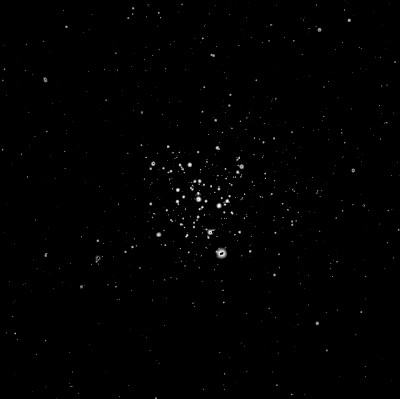
William Herschel discovered NGC 6649 = h3751 on 10 Jul 1787 and recorded "a cluster of very small and pretty compressed stars of various sizes; but it seems to be of the same nature with the Milky Way, which is at a little distance towards the south." Because of his uncertainty, he didn't assign it an internal discovery number or list it in his catalogues, but the position is a good match.
John Herschel found this cluster on 27 May 1835 and recorded "cl VIII class; a small well insulated group of a roundish figure, 5' diam; st 12...13 m; one * 9m, at the southern edge." His position is accurate. JH was credited with the discovery in the GC and NGC.
400/500mm - 17.5" (7/1/89): 40-50 stars in a 5' diameter, fairly rich, over unresolved haze. The brightest star is the close double ADS 11441 with components 9.7/11.4 at 4" located at the south edge.
Notes by Steve Gottlieb
NGC 6704
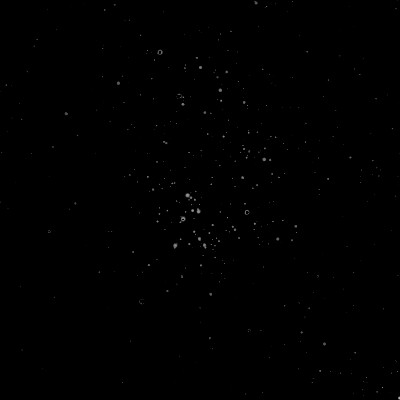
Friedrich August Winnecke discovered NGC 6704 = Au 43 on 23 Jul 1854 at age 19 with his personal 3-inch Metrz comet seeker at Gottingen. In AN 1072 he reported "In July 1854 I discovered a faint nebula in Scutum with the comet-seeker. In the Berlin refractor [9.6-inch Fraunhofer] it appears as a faint star cluster, but the place might be interesting, because it looks cometary in a small scope." Arthur Auwers measured an accurate position with the Konigsberg Heliometer (AN 1392) and described the cluster as elongated in the meridian (N-S), 3'x2'. He included it in his 1862 list of new nebulae.
400/500mm - 17.5" (7/1/89): at 220x, 40 stars mag 12-15 are visible over unresolved haze, elongated N-S. Three collinear mag 12.5 stars oriented NNW-SSE are equally spaced near the center. Located 55' N of M11.
Notes by Steve Gottlieb
NGC 6625
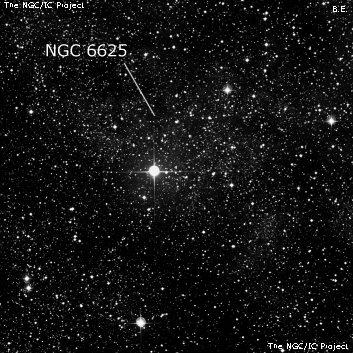
John Herschel discovered NGC 6625 = h2009 on 31 Jul 1826 and logged "A loose straggling cluster of stars 11...12m.". His position is very close to mag 5.7 HD 169033, although if his position is accurate I'm surprised he didn't mention the nearby bright star.
Harold Corwin identifies NGC 6625 with a group of stars (possibly a cluster) to the west of the bright star or perhaps a larger Milky Way field. Brian Skiff could not make a visual identification on two attempts and nothing stood out in my observation. Karl Reinmuth also reported no clustering was found on a Heidelberg Observatory plate. See Corwin's notes for more.
400/500mm - 17.5" (8/3/97): at 100x, appears to be a Milky Way field in a large triangular region roughly bordered by mag 5.7 HD 169033 star at the SE vertex, a mag 8 star ~12' NW and a mag 9 star ~9' W. This identification is uncertain as the region is completely indistinguishable from surrounding fields in star density and does not have any resemblance to a cluster although the Milky Way background seems locally brighter (also, JH does not mention the mag 5.7 star). At 220x, there is a fairly well-defined edge to portions of this Milky Way background and there is a small extension to the west near the star at the NW vertex. Listed as nonexistent in RNGC, though may be a true cluster. Located just east of Sh 2-54, a large, faint HII complex and the slightly enhanced Milky Way background may be caused by the glow of Sh 2-54.
Notes by Steve Gottlieb
NGC 6683
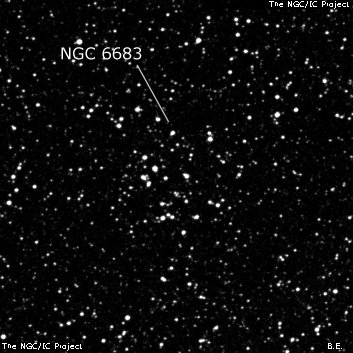
John Herschel discovered NGC 6683 = h2018 on 28 Jul 1827 and recorded "A more than usually condensed portion of the enormous cluster of the Milky Way. The field has 200 or 300 stars in it at once." His position is accurate. Based on Heidelberg plates, Karl Reinmuth noted "irregular clustering in extremely dense region, not well defined."
200/250mm - 8" (7/5/83): 10 faint stars in an elongated group over unresolved haze. The "Great Rift" is obvious just 10' W. In a rich field.
8" (7/16/82): elongated group of about 12 stars mag 11 and fainter in a rich star field.
400/500mm - 17.5" (7/1/89): about 20 faint mag 13-15 stars in two converging rows in a very rich field. The edge of the "Great Rift" is just 10' W (part of dark nebula B103) with an abrupt drop off in stars!
Notes by Steve Gottlieb
Abell 45
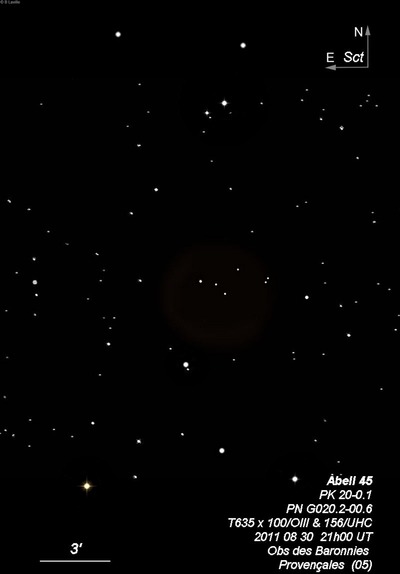
| Type | PN [3b] |
| RA | 18:30:15.4 |
| Dec | -11:36:57.0 |
| major_axis | 5.0' |
| mag | 12.9 |
| surface_bright | 16.1 |
M 1-59
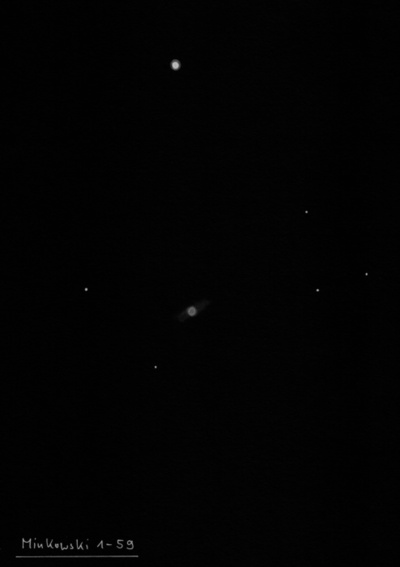
| Type | PN |
| RA | 18:43:20.2 |
| Dec | -09:04:49.0 |
| minor_axis | 48.0'' |
| mag | 13.3 |
| surface_bright | 7.4 |
Vy 1-4
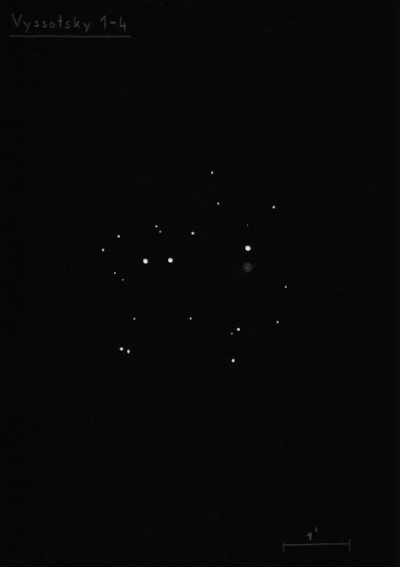
| Type | PN |
| RA | 18:54:01.9 |
| Dec | -06:26:20.0 |
| major_axis | 18.0'' |
| mag | 13.4 |
| surface_bright | 10.1 |
M 1-57
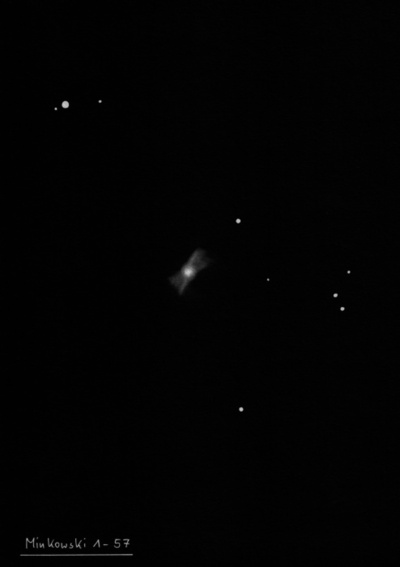
| Type | PN |
| RA | 18:40:20.3 |
| Dec | -10:39:47.0 |
| major_axis | 12.0'' |
| minor_axis | 6.0'' |
| position_angle | 3.0 |
| mag | 13.5 |
| surface_bright | 9.0 |
Pe 1-16
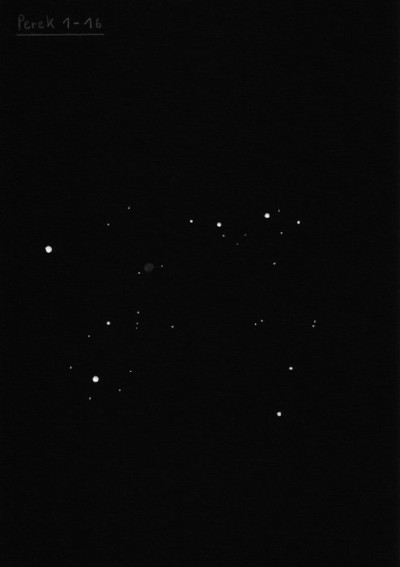
| Type | PN [2b] |
| RA | 18:47:32.3 |
| Dec | -06:54:04.0 |
| major_axis | 6.0'' |
| minor_axis | 18.0'' |
| position_angle | 1.0 |
| mag | 14.0 |
| surface_bright | 9.2 |
M 1-46
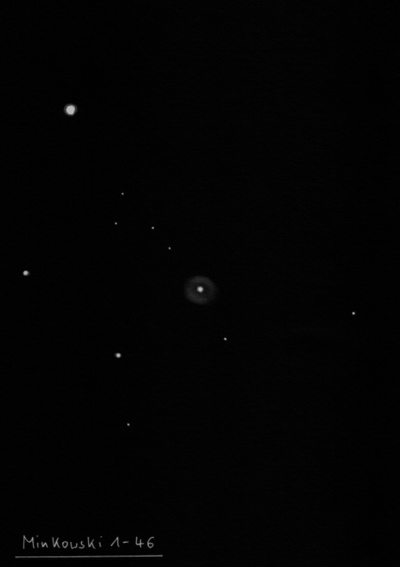
| Type | PN [4(2)] |
| RA | 18:27:56.3 |
| Dec | -15:32:54.0 |
| major_axis | 12.0'' |
| minor_axis | 6.0'' |
| position_angle | 7.0 |
| mag | 14.6 |
| surface_bright | 10.6 |
M 3-30
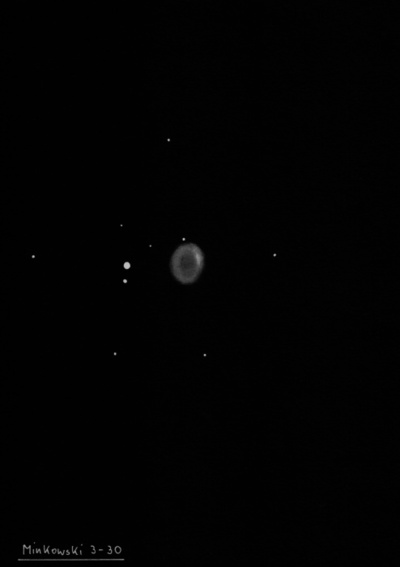
| Type | PN |
| RA | 18:41:14.9 |
| Dec | -15:33:44.0 |
| major_axis | 18.0'' |
| mag | 14.6 |
| surface_bright | 11.5 |
M 4-11
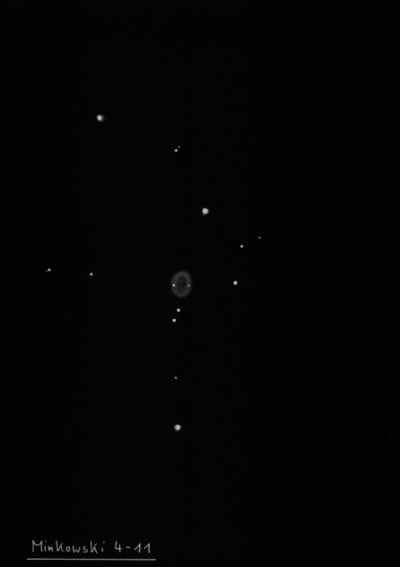
| Type | PN |
| RA | 18:54:17.7 |
| Dec | -10:05:14.0 |
| major_axis | 24.0'' |
| minor_axis | 18.0'' |
| position_angle | 3.0 |
| mag | 15.0 |
| surface_bright | 12.4 |
K 4-5
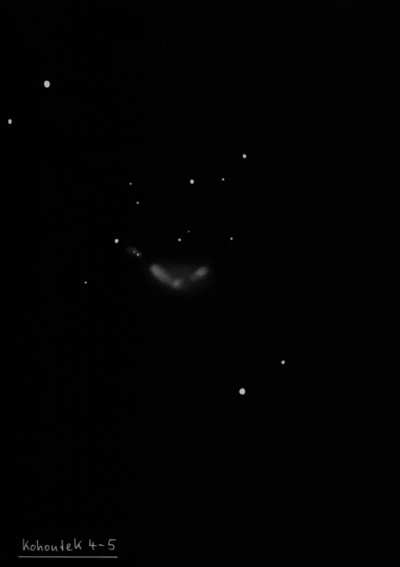
| Type | PN |
| RA | 18:45:36.7 |
| Dec | -06:18:40.0 |
| major_axis | 18.0'' |
| mag | 15.7 |
| surface_bright | 13.0 |
Abell 49
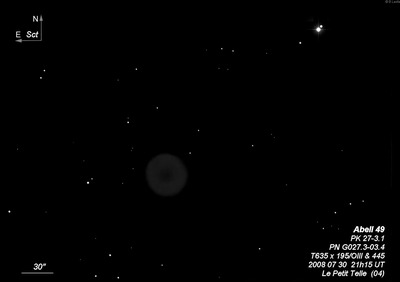
| Type | PN [2c] |
| RA | 18:53:28.3 |
| Dec | -06:28:47.0 |
| major_axis | 36.0'' |
| minor_axis | 36.0'' |
| mag | 16.7 |
| surface_bright | 15.2 |
GN 18.32.5

| Type | RNe |
| RA | 18:35:11.6 |
| Dec | -04:29:06.0 |
| major_axis | 48.0'' |
